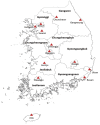Effects of Temperature and Pressure on Acute Stroke Incidence Assessed Using a Korean Nationwide Insurance Database
- PMID: 29037003
- PMCID: PMC5647635
- DOI: 10.5853/jos.2017.00045
Effects of Temperature and Pressure on Acute Stroke Incidence Assessed Using a Korean Nationwide Insurance Database
Abstract
Background and purpose: Many studies have evaluated the association between weather and stroke, with variable conclusions. Herein we determined the relationships between daily meteorological parameters and acute stroke incidence in South Korea.
Methods: Patients with acute stroke (2,894) were identified by standard sampling of a nationwide insurance claims database from January to December 2011. We used multiple Poisson regression analyses of stroke incidence and meteorological parameters (mean temperature, diurnal temperature change, temperature differences over the preceding 24 hours, atmospheric pressure, humidity, wind speed, and physiologically equivalent temperature) to calculate the relative risk of stroke incidence associated with meteorological parameters.
Results: There were no seasonal variations in the incidences of ischemic (2,176) or hemorrhagic (718) stroke. Temperature change during the day was positively correlated with ischemic stroke in men (relative risk [RR] 1.027; 95% confidence interval [CI] 1.006-1.05) and older patients (≥65 years) (RR 1.031, 95% CI 1.011-1.052). Temperature differences over the preceding 24 hours had a negative correlation with all strokes (RR 0.968, 95% CI 0.941-0.996), especially among older women. Diurnal variation of atmospheric pressure was also significantly associated with the incidence of ischemic stroke (age<65 years, RR 1.051, 95% CI 1.011-1.092; age≥65 years, RR 0.966, 95% CI 0.936-0.997).
Conclusions: Diurnal temperature change, temperature differences over the preceding 24 hours, and diurnal variation of atmospheric pressure were associated with daily stroke incidence. These findings may enhance our understanding of the relationship between stroke and weather.
Keywords: Atmospheric pressure; Cerebral hemorrhage; Cerebral infarction; Insurance, Health; Temperature.
Conflict of interest statement
The authors have no financial conflicts of interest.
Figures
References
-
- Ogata T, Kimura K, Minematsu K, Kazui S, Yamaguchi T; Japan Multicenter Stroke Investigators’ Collaboration. Variation in ischemic stroke frequency in Japan by season and by other variables. J Neurol Sci. 2004;225:85–89. - PubMed
-
- Wang Y, Levi CR, Attia JR, D’Este CA, Spratt N, Fisher J. Seasonal variation in stroke in the Hunter Region, Australia: a 5-year hospital-based study, 1995-2000. Stroke. 2003;34:1144–1150. - PubMed
-
- Oberg AL, Ferguson JA, McIntyre LM, Horner RD. Incidence of stroke and season of the year: evidence of an association. Am J Epidemiol. 2000;152:558–564. - PubMed
-
- Han MH, Yi HJ, Kim YS, Kim YS. Effect of seasonal and monthly variation in weather and air pollution factors on stroke incidence in Seoul, Korea. Stroke. 2015;46:927–935. - PubMed
LinkOut - more resources
Full Text Sources
Other Literature Sources



